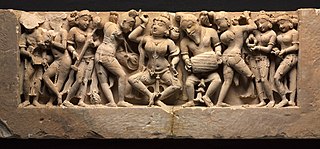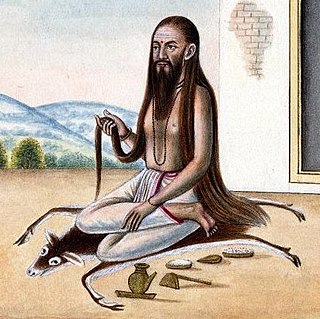Related Research Articles

Garuda is a Hindu deity who is primarily depicted as the mount (vahana) of the Hindu god Vishnu. This divine creature is mentioned in the Hindu, Buddhist, and Jain faiths. Garuda is also the half-brother of the Devas, Gandharvas, Daityas, Danavas, Nāgas, Vanara and Yakshas. He is the son of the sage Kashyapa and Vinata. He is the younger brother of Aruna, the charioteer of the Sun. Garuda is mentioned in several other texts such as the Puranas and the Vedas.

Indra is the king of the devas and Svarga in Hinduism. He is associated with the sky, lightning, weather, thunder, storms, rains, river flows, and war.

Balarama is a Hindu god, and the elder brother of Krishna. He is particularly significant in the Jagannath tradition, as one of the triad deities. He is also known as Haladhara, Halayudha, Baladeva, Balabhadra, and Sankarshana.

Airavata is a divine elephant, characterized by four tusks, seven trunks and a white complexion. He is the "king of elephants" also serves as the main vehicle for the deity Indra. It is also called 'abhra-Matanga', meaning "elephant of the clouds"; 'Naga-malla', meaning "the fighting elephant"; and 'Arkasodara', meaning "brother of the sun". 'Abhramu' is the elephant wife of Airavata. Airavata is also the third son of Iravati. In the Mahabharata he is listed as a great serpent.

Apsaras are a member of a class of celestial beings in Hindu and Buddhist culture. They were originally a type of female spirit of the clouds and waters, but, later play the role of a "nymph" or "fairy". They figure prominently in the sculptures, dance, literature and paintings of many South Asian and Southeast Asian cultures.
Kalki, also called Kalkin, is the prophesied tenth and final incarnation of the Hindu god Vishnu. According to Vaishnava cosmology, Kalki is destined to appear at the end of the Kali Yuga, the last of the four ages in the cycle of existence (Krita). His arrival will mark the end of the Kali Yuga and herald the beginning of the Satya Yuga, the most virtuous age, before the ultimate dissolution of the universe (Mahapralaya).

Svarga, also known as Swarga, Indraloka and Svargaloka, is the celestial abode of the devas in Hinduism. Svarga is one of the seven higher lokas in Hindu cosmology. Svarga is often translated as heaven, though it is regarded to be dissimilar to the concept of the Abrahamic Heaven.

Kubera also known as Kuvera, Kuber and Kuberan, is the god of wealth, and the god-king of the semi-divine yakshas in Hinduism. He is regarded as the regent of the north (Dikpala), and a protector of the world (Lokapala). His many epithets extol him as the overlord of numerous semi-divine species, and the owner of the treasures of the world. Kubera is often depicted with a plump body, adorned with jewels, and carrying a money-pot and a club.

Bharadvaja was one of the revered Vedic sages (maharishi) in Ancient India. He was a renowned scholar, economist, grammarian and a physician. He is one of the Saptarishis.

Mahabali, also known as Bali, Indrasenan, or Māveli, is a daitya king featured in Hinduism. He is the grandson of Prahlada, and a descendant of the sage Kashyapa. There are many versions of his legend, in ancient texts such as the Shatapatha Brahmana, Ramayana, Mahabharata, and several Puranas. According to Hindu literature, he was blessed to be one of the Chiranjivi, a group of seven immortals, by the Vamana avatar of Vishnu and reigns in the Sutaloka.

In various Asian religious traditions, the Nagas are a divine, or semi-divine, race of half-human, half-serpent beings that reside in the netherworld (Patala), and can occasionally take human or part-human form, or are so depicted in art. Furthermore, Nagas are also known as dragons and water spirits. A female naga is called a Nagi, or a Nagini. Their descendents are known as Nagavanshi. According to legend, they are the children of the sage Kashyapa and Kadru. Rituals devoted to these supernatural beings have been taking place throughout South Asia for at least 2,000 years. They are principally depicted in three forms: as entirely human with snakes on the heads and necks, as common serpents, or as half-human, half-snake beings in Hinduism and Buddhism.

Vasuki is the king of the nagas in Hinduism. He is described as having a gem called Nagamani on his head. Shesha, another king of the nagas and the bed on which Vishnu rests, is his elder brother, and Manasa, another naga, is his sister. In Hindu iconography, he is generally depicted coiling around the neck of Shiva, who is believed to have blessed and worn him as an ornament.
Pushan is a Hindu Vedic solar deity and one of the Adityas. He is the god of meeting. Pushan is responsible for marriages, journeys, roads, and the feeding of cattle. He was a psychopomp, conducting souls to the other world. He protected travelers from bandits and wild beasts, and protected men from being exploited by other men. He was a supportive guide, a "good" god, leading his adherents towards rich pastures and wealth.

The Yadava were an ancient Indian people who believed to be descended from Yadu, a legendary king of Chandravamsha lineage.

Naga Panchami is a day of traditional worship of nagas or snakes observed by Hindus, Jains, and Buddhists throughout India & Nepal, and other countries where Hindu, Jain, and Buddhist adherents live. The worship is offered on the fifth day of bright half of lunar month of Shravana (July/August), according to the Hindu calendar. Some Indian states, such as Karnataka, Rajasthan, Bihar and Gujarat, celebrate Naga Panchami on the dark half of the same month. As part of the festivities, a Naga or serpent deity made of silver, stone, wood, or a painting is given a reverential bath with milk and their blessings are sought for the welfare of the family. Live snakes, especially cobras, are also worshipped on this day, especially with offerings of milk and generally with the assistance of a snake charmer.

A Nagaraja is a king of the various races of the nāga, the divine or semi-divine, half-human, half-serpent beings that reside in the netherworld (Patala), and can occasionally take human form. Rituals devoted to these supernatural beings have been taking place throughout South Asia for at least two thousand years.
Janamejaya was a Kuru king who reigned during the Middle Vedic period. Along with his father and predecessor Parikshit, he played a decisive role in the consolidation of the Kuru state, the arrangement of Vedic hymns into collections, and the development of the orthodox srauta ritual, transforming the Kuru realm into the dominant political and cultural part of northern India. He also appears as a figure in later legends and traditions, the Mahabharata and the Puranas.

Ulupi, also known as Uluchi and Ulupika, is a Naga princess mentioned in the Hindu epic Mahabharata. Ulupi is the daughter of the king Kauravya, and is the second wife of Arjuna. She also finds a mention in the Vishnu Purana and the Bhagavata Purana.

In Indian religions, Patala, denotes the subterranean realms of the universe – which are located under the earthly dimension. Patala is often translated as underworld or netherworld. Patala is described as more beautiful than Svarga. Patala is described as filled with splendid jewels, beautiful groves and lakes.
References
- ↑ Gopal, Madan (1990). K.S. Gautam (ed.). India through the ages. Publication Division, Ministry of Information and Broadcasting, Government of India. p. 78.
- ↑ Dalal, Roshen (18 April 2014). Hinduism: An Alphabetical Guide. Penguin UK. p. 835. ISBN 978-81-8475-277-9.
- ↑ The Mahabharata: Volume 3. Penguin Books India. July 2012. p. 51. ISBN 978-0-14-310015-7.
- ↑ Viswanatha, S. V. (21 August 2013). Racial Synthesis in Hindu Culture. Routledge. p. 79. ISBN 978-1-136-38420-2.
